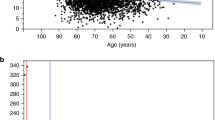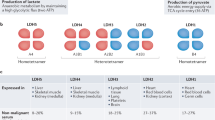Abstract
Dihydropyrimidine dehydrogenase (DPD) is the rate-limiting enzyme for degradation of 5-fluorouracil (5-FU). DPD activity is highly variable in liver and peripheral mononuclear cells (PMNCs) and it has not been well studied in human tumours. Characterization of DPD in colorectal cancer is of clinical interest through its role in the regulation of 5-FU, the main chemotherapeutic agent used in this disease. Therefore, DPD activity was analysed in colorectal tumour and adjacent normal tissue from 63 patients, including three liver metastasis. DPD activity was highly variable in all tissues studied (coefficient of variation 43-61%) and was higher in normal tissue than in tumour. The tumour-normal activity ratio ranged from 0.19 to 3.32 (median 0.76). PMNC DPD activity was available for 57 patients and was correlated with tumour activity (r(s) = 0.29, P < 0.001). A higher correlation was observed between PMNCs and tumour samples that were both obtained in the morning (r(s) = 0.49), consistent with circadian variation in DPD activity. Normal tissue DPD activity was not correlated with either tumour (r(s) = 0.11) or PMNC activity (r(s) = -0.06). This study provides the first analysis of DPD activity in colorectal cancer and illustrates the large degree of variation in tumour activity. The tumour-normal activity ratio results suggest that elevated tumour DPD can play a role in 5-FU resistance through increased inactivation in tumour cells, but is an uncommon event in colorectal tumours. The results support the use of PMNCs for monitoring tumour DPD activity, particularly when circadian variation is taken into account. As a large degree of the variation in tumour DPD activity is not explained by PMNC activity, more accurate alternatives are needed before DPD activity can be used for targeting 5-FU therapy.
This is a preview of subscription content, access via your institution
Access options
Subscribe to this journal
Receive 24 print issues and online access
$259.00 per year
only $10.79 per issue
Buy this article
- Purchase on Springer Link
- Instant access to full article PDF
Prices may be subject to local taxes which are calculated during checkout
Similar content being viewed by others
Author information
Authors and Affiliations
Rights and permissions
About this article
Cite this article
McLeod, H., Sludden, J., Murray, G. et al. Characterization of dihydropyrimidine dehydrogenase in human colorectal tumours. Br J Cancer 77, 461–465 (1998). https://doi.org/10.1038/bjc.1998.73
Issue Date:
DOI: https://doi.org/10.1038/bjc.1998.73
This article is cited by
-
First report about the identification and preliminary analysis of a partial sequence of dihydropyrimidine dehydrogenase (NADP+) in Thermopsis turcica during floral development using degenerate primers
Acta Physiologiae Plantarum (2017)
-
Tissue Metabonomic Phenotyping for Diagnosis and Prognosis of Human Colorectal Cancer
Scientific Reports (2016)
-
Integrative metabonomics as potential method for diagnosis of thyroid malignancy
Scientific Reports (2015)
-
Role of thymidylate synthase and dihydropyrimidine dehydrogenase mRNA expressions in gallbladder carcinoma
Surgery Today (2012)
-
Role of thymidylate synthase and dihydropyrimidine dehydrogenase mRNA in intrahepatic cholangiocarcinoma
Surgery Today (2012)



